# Shift 5 Hack Challenge
Team: Thomas Maillart, Oleg Lavrovsky, Yannick Heiniger
### *Executive Summary*
This project responds to Shift Five - Peace and Prevention, and Sustainable Development Goals 16 and 17. Our proposition: Hackathons are the ideal grounds for technical-artistic experimentation, collaboration, and partnership. As proof, we quickly analyzed, researched and published a new article about "The Dream of Peace": a prominent historic artwork, and a familiar backdrop to research and communication work at the United Nations. Our belief is that this artwork serves as a daily reminder of the universal paradigm of prevention and peace, echoing Recommendation 1: "Commit to our collective security". This was confirmed by collaborators from the UN Library & Archives, who were open to our ideas and very helpful in research efforts. Our project suggests a few ways in which Artificial Intelligence, Digital Archives, and Open Collaboration within a hackathon setting can support, promote, and venerate sustainable peacemaking processes in the future.


### *Challenge statements*
* A virtual art studio inspired by Henrik Sørensen. In the center are symbols of the issues. Above the warring sides, the steps towards a peaceful and diplomatic solution are visualized. The generative paintings are easily hackable, revisions made by other AIs or humans shown next to them. Stretch goal: generative music for peace. (Oleg)
* Bringing together people who do not have anything in common to do stuff together is a powerful way to bring sustainable peace. Hackathons are an instrument for peace as they build on the diversity of perspectives of people who do not necessarily know each other. (Thomas, Yannick)
These two challenge statements were proposed, then combined together at a sprint dedicated to 2030 Agenda at the [United Nations Library & Archives](https://www.ungeneva.org/en/library-archives/library) in Geneva on November 8, 2023 with participants of the [Hack the Hackathon v3](https://hackthackathon.github.io/) conference.
### *Results*
In this document, you can find the results of our short sprint together. This includes:
- The [brainstorming](#Brainstorm) and [moodboards](#Moodboard) of our ideas
- Artistic and A.I. [interpretations](#Interpretation) of The Dream of Peace
- A new [Wikipedia](#Wikipedia) page that we created for The Dream of Peace painting
### *Gratitude*
♥ 📖 Special thanks to Adeline, Christina and Colin, staff members of the UN library, for their valuable inputs and assistance to find the references and power up our project.
# Brainstorm
* Use art to make hackathons more bounding to strengthen communities - any type of hackathon, even the most technical, should integrate art and science.
* With hackathons, technology itself is not the end purpose: and we know that art is vital.
* Celebrate the failure of technology (post about blue screen) => humorous, “scandalous”, etc.
* Art for inter-cultural understanding. Art for healing. Art for transcendence.
* What is fascinating about the event here, is that it is structuring skillsets, and the “good” spirit. What Art could add to this ?
* Hackathons mirror the problems of society.
* Mental state and art: mental health in hackathon matters.
* Hackathon: Taking conflict on leash ! ⇔ Peace => handling conflict in a positive way !
* Finding the roots of hacker D.N.A., the common ground, iteratively and improvisationally.
* Let's play music with friends to wind down after the co-creation.
* “Shared data on peace should be considered a global public good”: hackathons based on open data, bolstering understanding of the costs of conflict and the pathways to peace should be part of the global security architecture.
## Moodboard
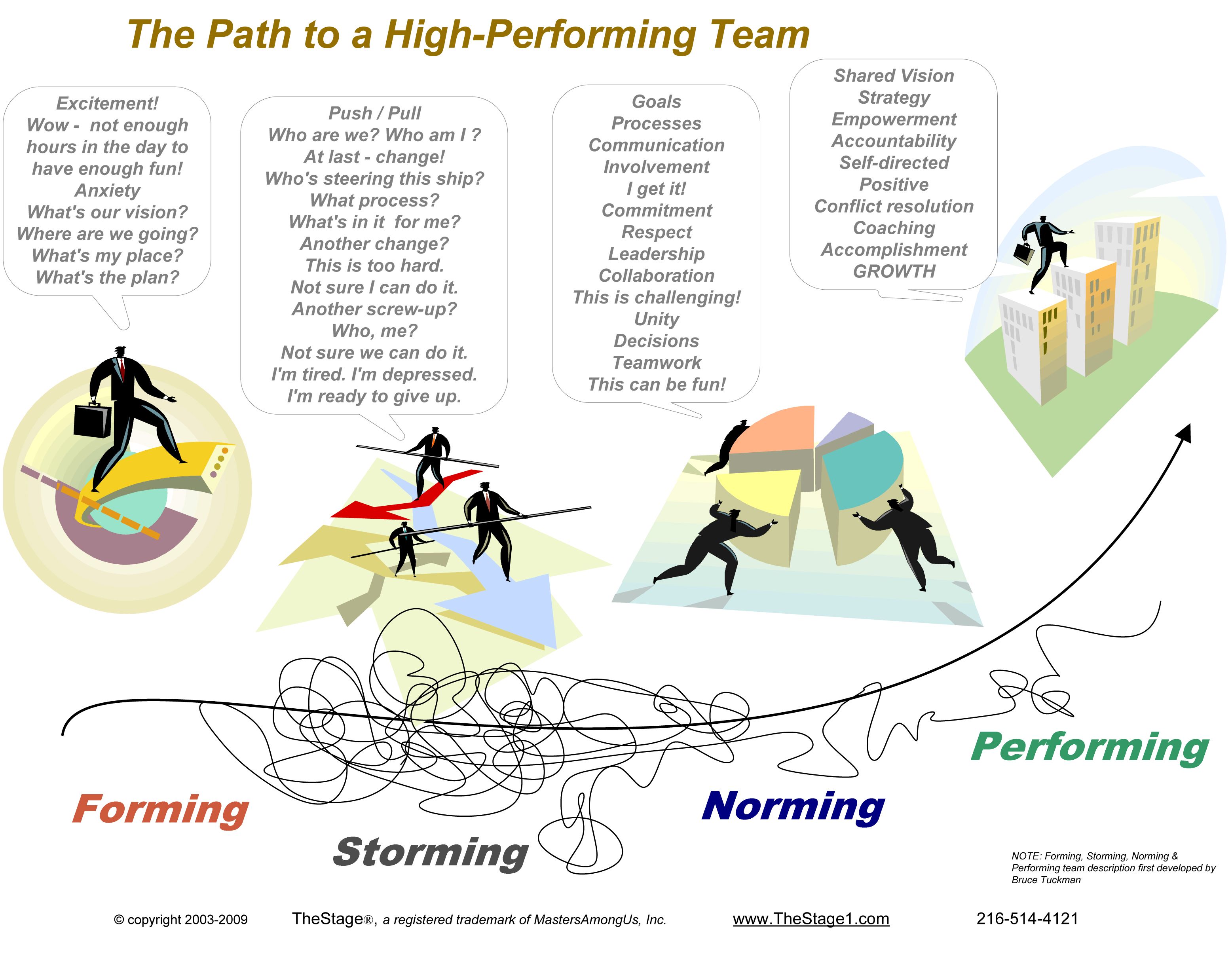
_Image from a Wordpress blog via [Pinterest](https://www.pinterest.com/pin/103864335126367775/) that we discussed, a popular metaphor of conflict-management that leads to cooperation._

_Painting by Abbas Al Mosawi of Roundabout monument, donated by Bahrain to the United Nations Human Rights Council (UNHRC)_
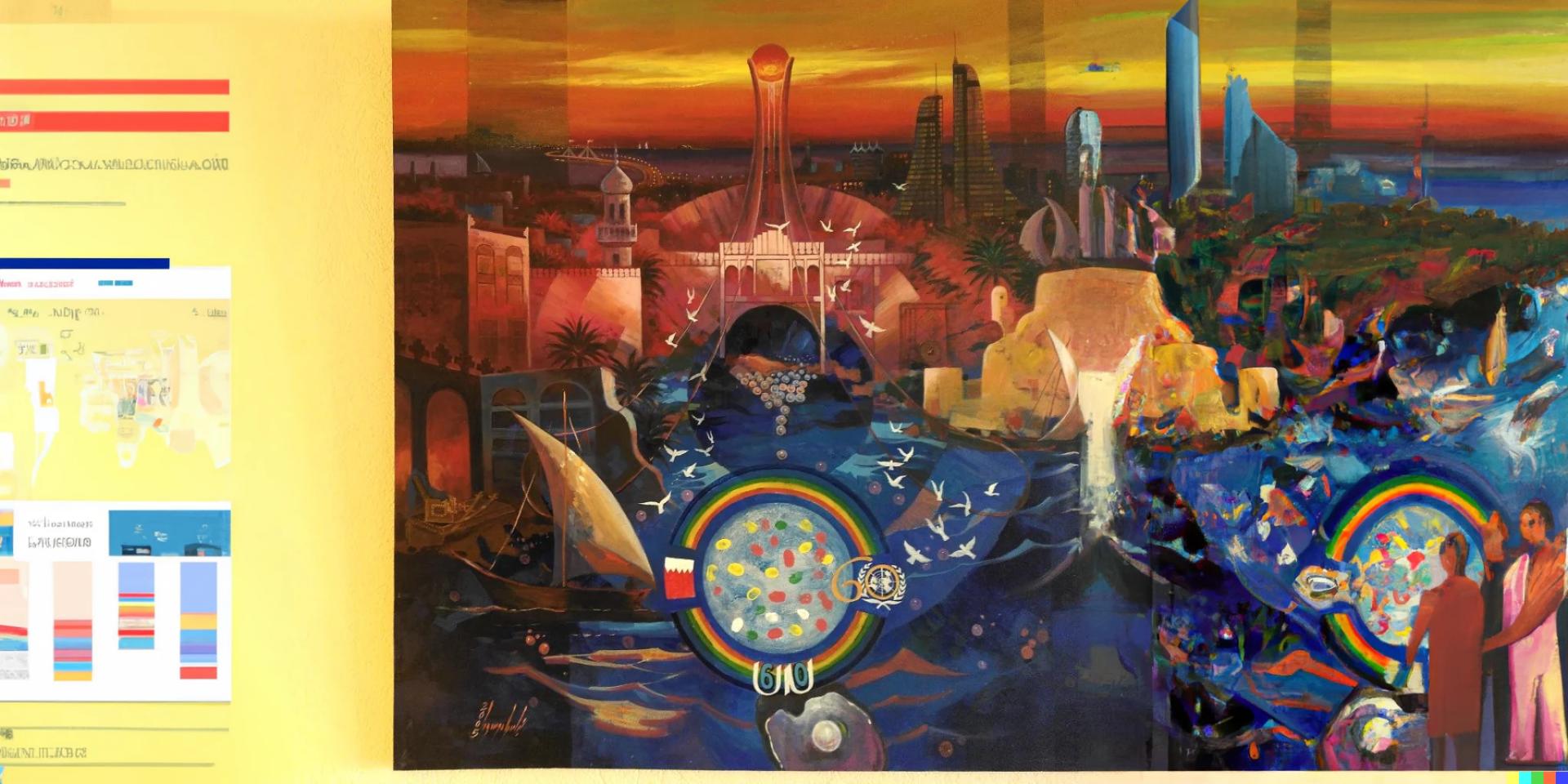
_The same painting that has been extended by us with the help of generative AI (DALL·E) on 2023-11-08._
# Interpretation
Our brainstorm led us to a deeper analysis of the gigant painting by Henrik Sørensen that is the centerpiece of the UN Library where we worked. With its position behind the speakers, it takes the physical space that is normally at hackathons reserved for team presentations. In other words, every public discussion or presentation in the Library would inevitably have participants take in some of the artwork.
During our research conducted with the help of staff members of the Library & Archives, we made the happy discovery, that the painting was not a solo work, but indeed a team effort. This is not surprising considering the scale of the effort. Nevertheless this is not a widely known fact, and we hope that these assistants - Georg Jacobsen and Cathrine Riddervold, who along with the "ideator" Halvdan Koht will be given due credit through scholarly research in the future.
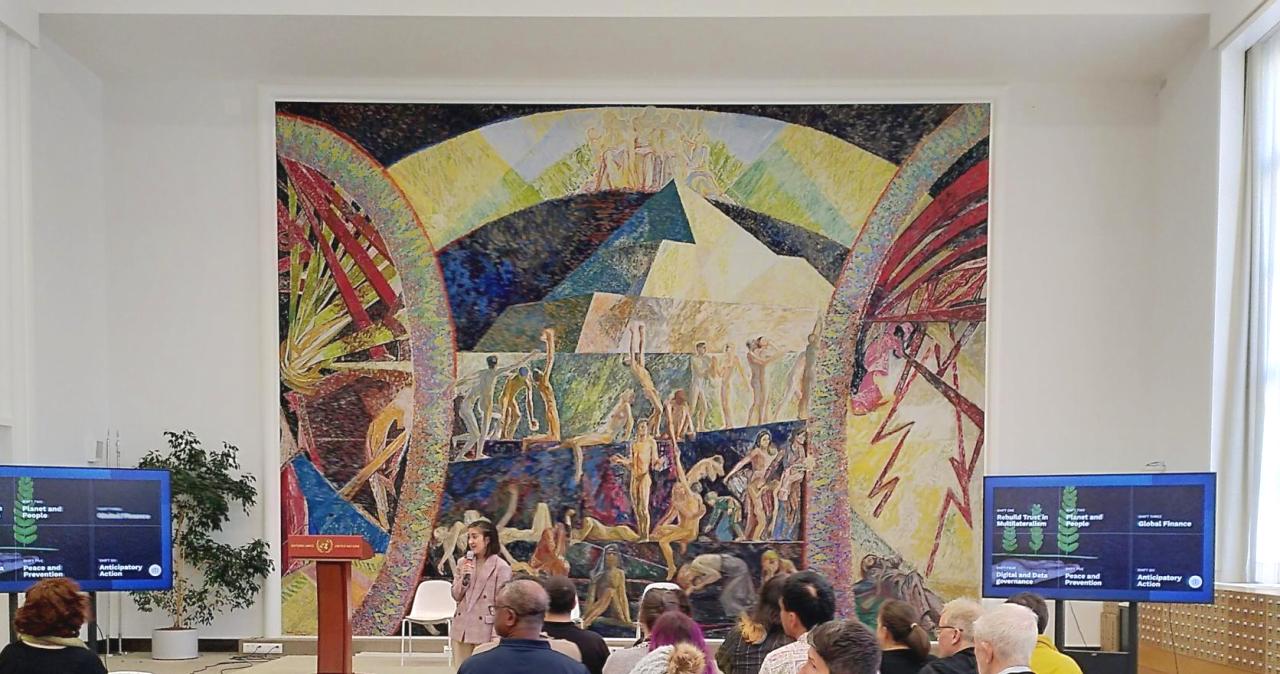
Photographs do not adequately represent the scale and grandeur of the painting. It is quite a visceral experience to approach it, and see that the people are almost life-sized. There are a lot of hidden details, some of which are described in a leaflet that is available in the room.

_A black and white photograph from the Archive._
This is a transcript from the leaflet of an interpretation written by the artist himself:
> “The Dream of Peace! The left part of the picture provides an image of the totalitarian war. A home in happy blue, rose and green colours. The child sits in the middle. All this is splintered by the war. To the right, the human being as a uniformed machine, in the position of Golgotha. These two images of destruction create the dream and demand for the millennium – the definitive peace. The two arcs created by the colours of these two areas have a form based on the ornamentation of light. At the top of the picture the arcs create an area with the mothers of five continents and their children, symbolising peace.
>
> The central motif is the pyramid, symbol of the ancient ascending principle. At the bottom are the defeated people, the unhappy mothers with their children. In the middle sits the oriental woman – but with a dash of blue hope over her bloody headdress. To the left are the two human birds, the “Paolo and Francesca” of the time – the humans clutching to one another in hard times.
>
> In the axis of the pyramid the new human being rises with the shadows from the level of destruction of the picture. To the right, the persecuted people, refugees and children of famine – but in the green colour of hope. In the middle level of the pyramid the colour of light and darkness meet.
-- Henrik Sørensen, October 1939
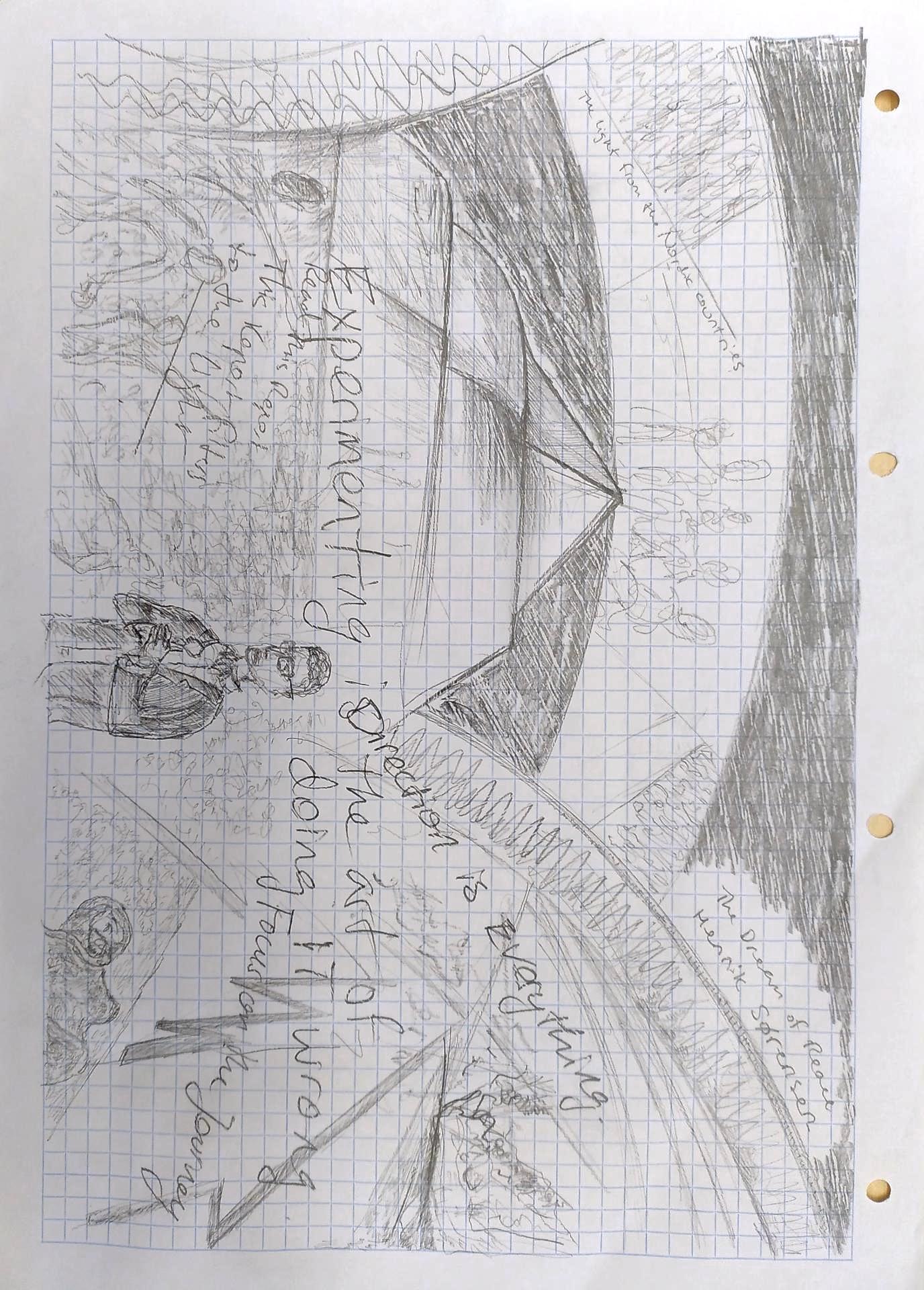
During the introduction presentation today, Oleg made this analytical sketch of the painting. In front of it stands Francesco Pisano, Director of the UN Library & Archives, who introduced us to the event and whose words to us are written inside and around and the subject matter and several characters of the artwork.
Responding to the stated challenge, we then uploaded our photograph of The Dream of Peace into Stable Diffusion, an open source tool for generative art based on artificial intelligence. We combined this with prompts like "pacifism, culture, technology, vision of the future, robotic society" to generate several A.I.-interpretations of the painting.
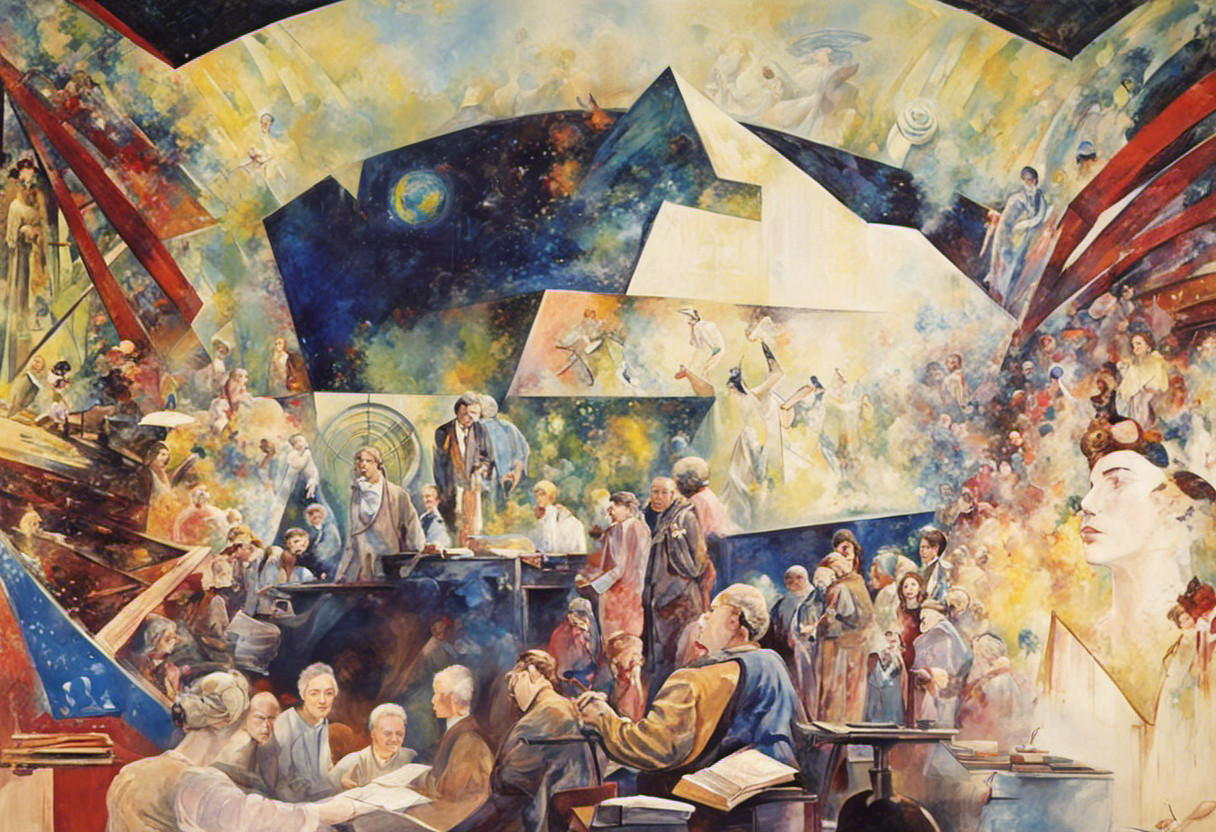
_A.I. interpretation of the Dream of Peace, made using Stable Diffusion XL v1 and GIMP._
We combined the best versions of these together using the open source photo-editing program GIMP for the final rendering shown above, which juxtaposes visions of the future: the Earth seen from space, humans of many cultures, birds and animals, the United Nations Logo, scholarly work and debate. These are embedded into the structure of the original painting. Notice how the central element, the pyramid, is slightly misshapen by a dent, symbolizing (we feel) the costs and compromises of peacemaking.
We even tried to reintroduce violent imagery through the prompts, at least to bring back the dying soldier of the bottom right in the original painting. However, the A.I. model we are using blocked us from doing this based on an encoded moral ruleset. In that sense, the machine learning model also fulfills the premise of a "Dream of Peace".
# Wikipedia
During our investigations, we realised that there was no entry on Wikipedia documenting the large and prominent painting "The Dream of Peace" - in French, "La rêve de la paix". We decided to dedicate our remaining time and energies to proposing its creation and researching the topic further. Here is a link and our draft text and submission status:
https://en.wikipedia.org/wiki/Draft:The_Dream_of_Peace
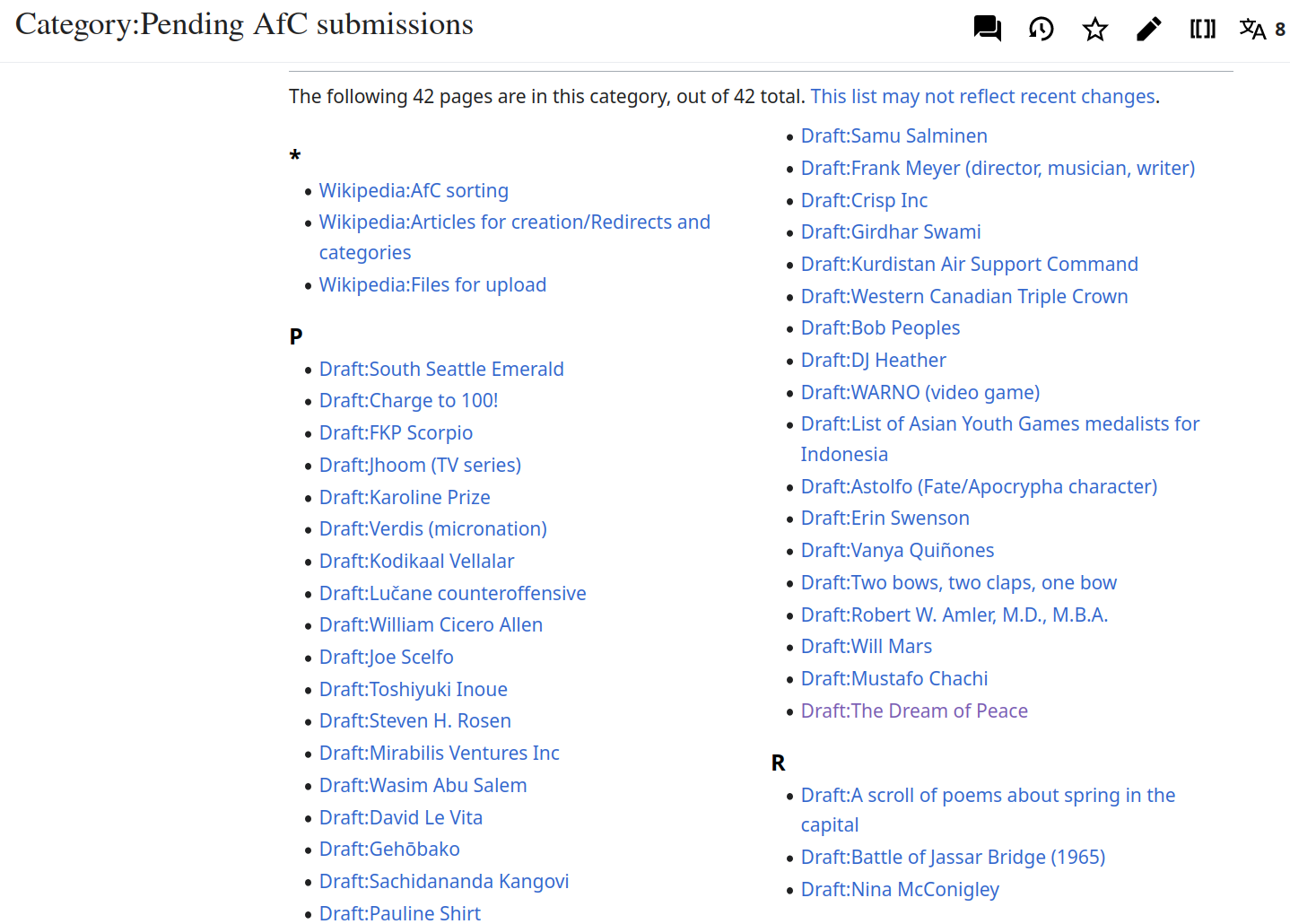
### *Article draft*
---
The Dream of Peace is an 8.6 meters wide and 6.5 meters tall canvas oil painting by Norwegian artist, Henrik Sørensen (b. 1882 – d. 1962), depicting themes of war, defeat, and hope for humanity. It is on permanent display in the United Nations Library & Archives in Geneva.
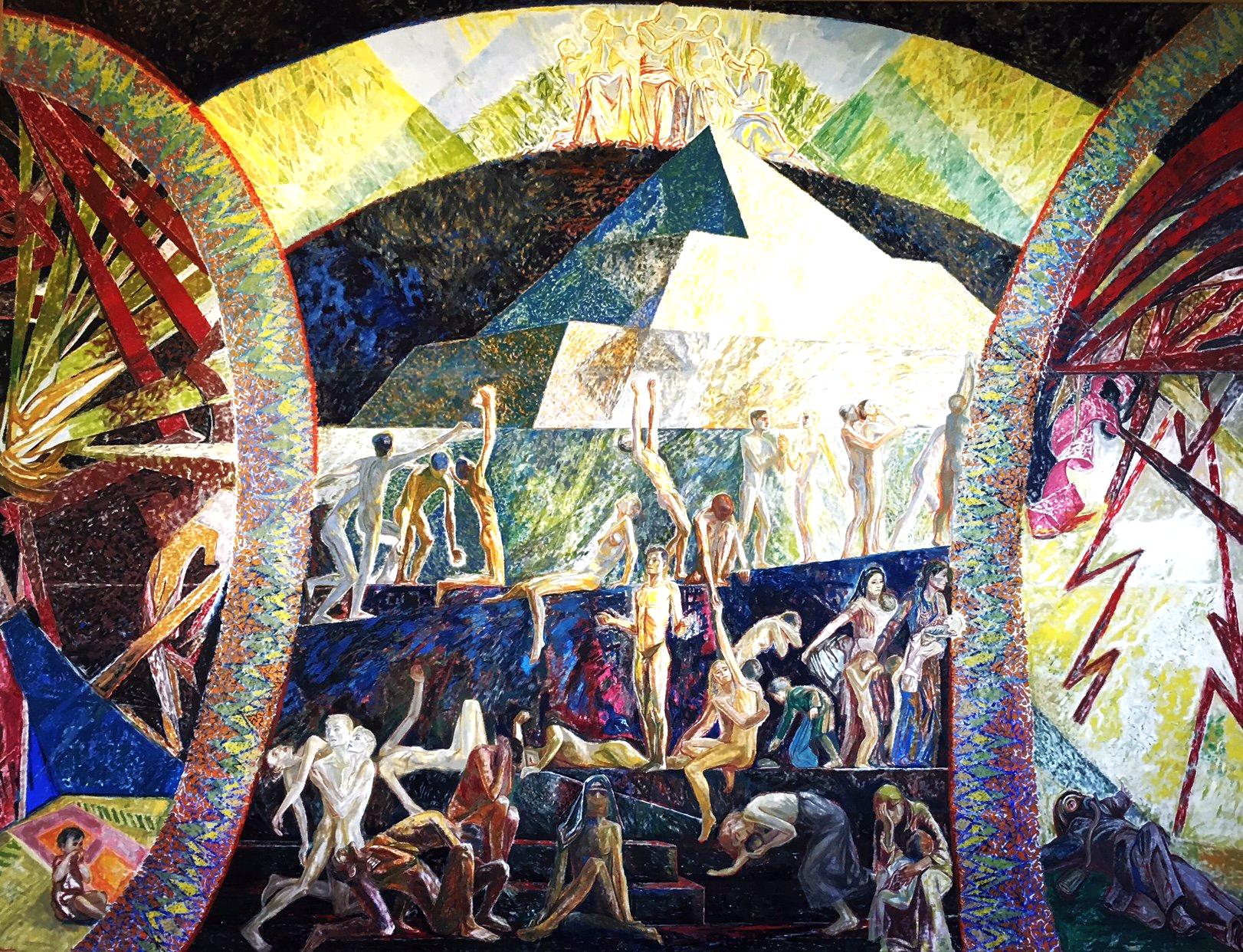
#### History
Commissioned in 1937 by the Norwegian government, it was over two years in production[1]. Several other painters contributed to the painting. The constructivist Georg Jacobsen, extraordinary professor in the period of 1936-40 at the Academy of Fine Arts in Oslo, designed the pyramid. Sørensen had a student, Cathrine Riddervold, who acted as an assistant: among other things, painting the two large ornamental arches that separate the pyramid from the two side panels.[1]
It was Halvdan Koht - at the time Norway’s Minister of Foreign Affairs - who together with Carl J. Hambro - then President of the Parliament - made the commission that put the painters to task.[2] After being shortly displayed at the House of Artists in Oslo in November 1939, the work was rolled up and brought by train to Geneva[2]. There it was mounted in the Palace of Nations to adorn the Great Reading Room of the United Nations Library & Archives, a place of calm and contemplation[2]. The mural was inaugurated in December 1939 in the presence of C. J. Hambro, the then-President of the Assembly of the League of Nations.
#### Composition
The initial sketch of The Dream of Peace was quite different from the final painting. It depicted a rising sun and a frieze featuring portraits of the founding fathers of the League of Nations idea. The project was rejected, and the current composition, themed around the dream of peace, was chosen. The artist describes the work as follows:
The left part of the painting aims to represent totalitarian war, with a hearth in happy colors of blue, pink, and green. The child occupies the center of this section, all of which is shattered by war. The right part depicts man as a standardized machine, deployed in a Golgotha pause. These two representations of ruins create the dream and the right to the millennium, and to ultimate peace. The two arcs harmonize with the colors of the two aforementioned parts. Their pattern is constructed on the monumental art of light. At the top of the painting, The arcs form the section gathering the mothers of the five parts of the world, with their children, symbolizing peace. The central motif represents a pyramid, which is a symbol of the ancient principle of ascending humanity. At the bottom are the defeated peoples, the unfortunate mothers, and their children. In the middle of the painting sits the oriental woman, with a glimmer of blue hope above her bloody headdress. To the left, wo bird-like beings, "Paolo and Francesca," take refuge near each other in difficult times. In the axis of the pyramid rises the new man, with the projected shadows of the ruins' plan in the painting. To the right are the displaced peoples, the refugees, and the children of famine—but in the hopeful green colors. In the middle part of the pyramid, the colors of shadow and light meet. In the surges of this battle between shadow and entirely victorious light, man awakens, stands, and walks—upwards, towards the light. For one day... to meet the dream and the definitive peace.
Color plays a crucial role in this painting. The message is emphasized by the use of blue and green tones, colors of hope, and lighter hues of the sun to guide the dream of humanity. The characters lack physical power and majesty. On the contrary, they are instead slender and uniform. The iconographic ensemble recalls the triangular compositions of the Last Judgment, where paradise and hell are separated, one depicted on the left and the other on the right. The golden frame of the painting is meant to represent a halo.[3]
According to the artist's son, Sven Oluf Sørensens, when asked for the seemingly ridiculous message of peace in the middle of a war, the painter replied: "Oh yes, but I do not know who is most ridiculous: I, having believed in a kind of ascending sunrise for humanity, or those others who are content to be swallowed by the ascending darkness."[2]
Further References
Jong, Anneleen de (2001). La représentation de l'humanité (in French). Genève: Nations Unies. ISBN 92-1-200357-5.
Sørensen, Sven Oluf; Sørensen, Henrik Ingvar (2003). Søren (in Norwegian). ISBN 978-82-7694-137-1.
"The Dream of Peace". Norgesportalen. 2018-09-21. Retrieved 2023-11-09.
External Links
UN Digital Library - Le rêve de la paix / Henrik Sørensen
Mural.ch - Geolocated works of art
Norway in Geneva - The Dream of Peace
Womens International League for Peace & Freedom
Hoff, Svein Olav (1992). Henrik Sørensen (in Norwegian). Gyldendal. p. 211. ISBN 82-05-20945-6.
The Dream of Peace. Leaflet published in 2018 by the Permanent Mission of Norway to the United Nations, in close collaboration with Ms Torild Skard. UN/LIB/2019/16
## References
1. The Dream of Peace. Leaflet. Permanent Mission of Norway, in close collaboration with Ms Torild Skard. April 2019 UN/LIB/2019/16
2. La Représentation de l'humanité. Page 408. Anneleen de Jong, Nations Unies, 2001. UN/LIB/2001/68. ISBN 92-1-200357-5
3. Søren. Page 210. Sven Oluf Sørensens, 2003. ISBN 978-82-7694-137-1
4. Henrik Sørensen. Page 209-212. Svein Olav Hoff. ISBN 82-05-20945-6
## Links
- [UN Digital Library - Le rêve de la paix / Henrik Sørensen](https://unog.primo.exlibrisgroup.com/permalink/41UNOG_INST/s5qper/alma991000638468102391)
- [Mural.ch - Geolocated works of art](https://www.mural.ch/index.php?kat_id=w&sprache=eng&id2=1024&alimit=0&prozess=1&submitted=2&submitted2=)
- [Norway in Geneva - The Dream of Peace](https://www.norway.no/en/missions/wto-un/our-priorities/other-issues/events/the-dream-of-peace/)
- [Womens International League for Peace & Freedom](https://www.ikff.no/the-dream-of-peace/)